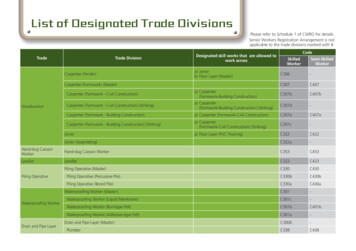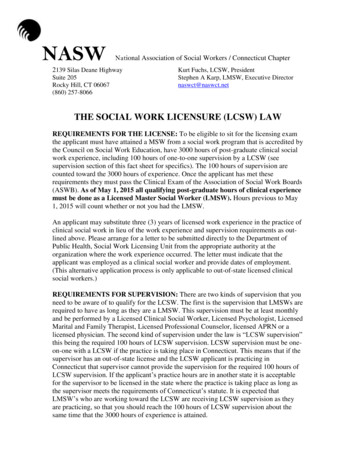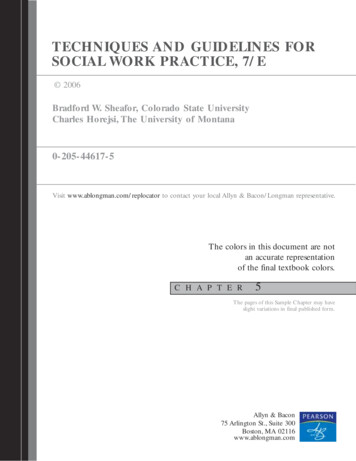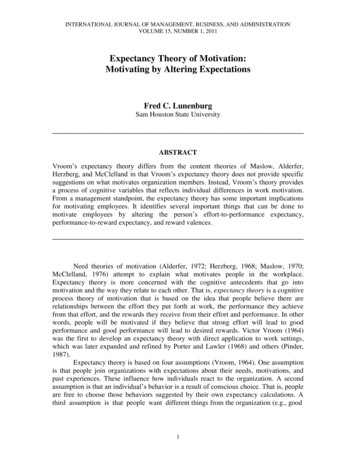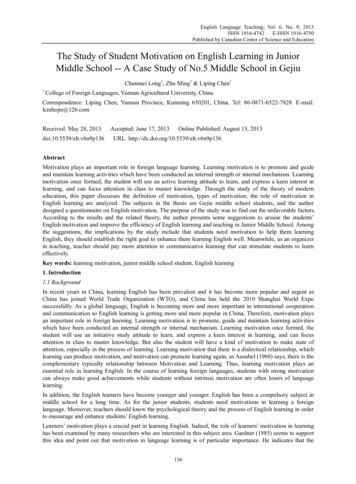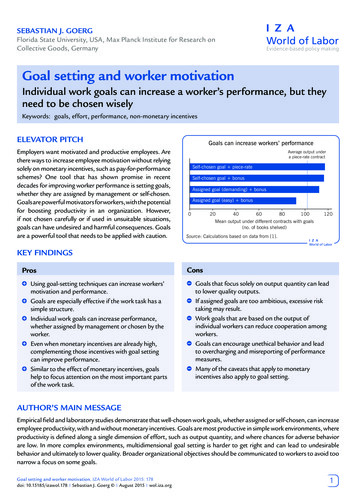
Transcription
Sebastian J. GoergFlorida State University, USA, Max Planck Institute for Research onCollective Goods, GermanyGoal setting and worker motivationIndividual work goals can increase a worker’s performance, but theyneed to be chosen wiselyKeywords: goals, effort, performance, non-monetary incentivesELEVATOR PITCHEmployers want motivated and productive employees. Arethere ways to increase employee motivation without relyingsolely on monetary incentives, such as pay-for-performanceschemes? One tool that has shown promise in recentdecades for improving worker performance is setting goals,whether they are assigned by management or self-chosen.Goals are powerful motivators for workers, with the potentialfor boosting productivity in an organization. However,if not chosen carefully or if used in unsuitable situations,goals can have undesired and harmful consequences. Goalsare a powerful tool that needs to be applied with caution.Goals can increase workers’ performanceAverage output undera piece-rate contractSelf-chosen goal piece-rateSelf-chosen goal bonusAssigned goal (demanding) bonusAssigned goal (easy) bonus020406080100120Mean output under different contracts with goals(no. of books shelved)Source: Calculations based on data from [1].KEY FINDINGSProsUsing goal-setting techniques can increase workers’motivation and performance.Goals are especially effective if the work task has asimple structure.Individual work goals can increase performance,whether assigned by management or chosen by theworker.Even when monetary incentives are already high,complementing those incentives with goal settingcan improve performance.Similar to the effect of monetary incentives, goalshelp to focus attention on the most important partsof the work task.ConsGoals that focus solely on output quantity can leadto lower quality outputs.If assigned goals are too ambitious, excessive risktaking may result.Work goals that are based on the output ofindividual workers can reduce cooperation amongworkers.Goals can encourage unethical behavior and leadto overcharging and misreporting of performancemeasures.Many of the caveats that apply to monetaryincentives also apply to goal setting.AUTHOR’S MAIN MESSAGEEmpirical field and laboratory studies demonstrate that well-chosen work goals, whether assigned or self-chosen, can increaseemployee productivity, with and without monetary incentives. Goals are most productive in simple work environments, whereproductivity is defined along a single dimension of effort, such as output quantity, and where chances for adverse behaviorare low. In more complex environments, multidimensional goal setting is harder to get right and can lead to undesirablebehavior and ultimately to lower quality. Broader organizational objectives should be communicated to workers to avoid toonarrow a focus on some goals.Goal setting and worker motivation. IZA World of Labor 2015: 178doi: 10.15185/izawol.178 Sebastian J. Goerg August 2015 wol.iza.org1
Sebastian J. Goerg Goal setting and worker motivationMOTIVATIONGoals are everywhere in human life and organizations. For example, in our privatelife we set goals for saving money and losing weight. In politics, politicians debatefiscal goals, goals for reducing carbon dioxide emissions, and goals for job and wagegrowth, among many others. Similarly, in our working life we try to achieve tenure orpromotions. At work, we may face sales goals, revenue goals, project milestones, andproduction goals. Some of these goals are specific, some are vague, some are binding,and some are backed up by monetary incentives. And some goals are self-chosen whileothers are imposed externally.New forms of management structure in recent decades, such as management byobjectives, described by Peter Drucker in the 1950s, have been heavily influenced bygoal-setting approaches. In particular, large technology firms such as Google, Intel,and Twitter have started to use goal-setting approaches to provide real-time feedbackto their workers.In psychology, the research on goal setting has a long tradition. Studies haveconsistently demonstrated that an individual’s behavior is affected by goals and that,if well chosen, goals can boost individual productivity. More recently, economists havejumped on the goals bandwagon, adding formal theories to model the functioningof goals and contributing to the empirical evidence. While many studies have foundpositive effects of goal setting, some cautionary notes on possible adverse side effectshave emerged from this research.DISCUSSION OF PROS AND CONSProperties of well-designed goalsManagement theorists and practitioners broadly agree that goals should be specific,measurable, attainable, relevant, and timed (SMART). Specific means a well-definedgoal in an explicitly established unit of measurement (such as dollars for revenue, piecesfor output, and pounds for weight loss) as opposed to a simple “do your best” rule.Measurable refers to the ability to observe progress so that an individual (and observer)knows how close goal attainment is. A goal should be attainable, which means that anindividual has a realistic chance of achieving the goal. To be relevant, a goal needs tobe meaningful and worth achieving for the individual or the organization. And finallytimed implies that there should be some time limit for reaching the goal (for example,lose five pounds by the end of the month or increase revenue by 100,000 in the firstquarter of the year).Positive effects of goalsAmong economists, the prevalent view on goal setting is that workers are driven bytwo types of motivation. First, they are extrinsically motivated by the wages theyreceive, and second, they are intrinsically motivated to reach their personal goals.Consequently, goals provide a reference point against which workers can measuretheir satisfaction (utility) by dividing outcomes into gains, when the goal is attained,and losses, when output falls below the goal [2], [3], [4], [5]. In line with prospectIZA World of Labor August 2015 wol.iza.org2
Sebastian J. Goerg Goal setting and worker motivationtheory, losses (outputs below the goal) hurt more than gains (outputs above the goal)feel good. Consequently, workers will be risk-seeking and willing to exert higher effortto prevent the dissatisfaction (disutility) experienced as a result of failing to attain thegoal.Increased productivityOrganizations often combine work goals with bonuses that are paid once the goal isreached. In those settings, a worker could be motivated not only by the goal itself, butalso by the prospect of a monetary reward. However, even goals that are not linked tomonetary rewards can be very effective in increasing productivity. In a recent laboratoryexperiment, subjects in the role of workers had to engage in a laborious mathematicstask requiring close effort for 1.5 hours [5]. Each correct solution generated revenuethat was split equally between the worker and a manager. The higher the number ofproblems the worker solved, the higher the earnings for the worker and the manager.Because the task was long and required close concentration, workers had the optionof taking breaks to engage in some on-the-job leisure activity. Workers could explorethe internet whenever they wanted or needed a break. Some managers could assigngoals in the form of an explicit number of correctly solved problems. Achieving ornot achieving the goals did not affect the amount of earnings workers received, andmanagers were unable to fire workers who did not achieve their goals.In this setting, goals had no direct influence on the final earnings of workers.Still, when given the option to set goals, managers did so, setting goals that werechallenging but attainable for an average worker. Workers responded to the goals byincreasing their output and decreasing their on-the-job leisure activities. Thus, goalsseem to be a means of transmitting managers’ expectations to workers, and workersrespond. Although the assigned work goals do not affect wages, they indirectly boostthe earnings of workers and their managers by increasing productivity. Goals wereeffective in boosting productivity even when monetary incentives were already high—even when workers were already being paid a high sum for each correct solution.The effectiveness of assigned work goals for improving productivity has also beenconfirmed in field experiments. In field experiments, subjects are observed in real workenvironments while being unaware of their participation in a scientific experiment.Thus, field experiments allow for the implementation of subtle manipulations withoutsubjects feeling the experimenters’ scrutiny. One field experiment was implementedin a research institute library that needed to be restructured [1]. During therearrangement, roughly 35,000 books had to be found and moved from one shelfto another. Temporary workers hired for this one-time-only job were the unknowingparticipants in an experiment on goal setting.For some workers, librarians assigned goals for the number of books to be locatedand reshelved during a shift. In line with the findings of the laboratory study, havinggoals did increase workers’ productivity—in this case by 15% compared with a baselinecase without goals (see the illustration on p. 1). Other workers were free to choosetheir own goals before starting work. Again, having a goal increased workers’ outputby 15%. Thus, the same positive effect was observed whether the goal was assignedby a manager or chosen by the worker [1].IZA World of Labor August 2015 wol.iza.org3
Sebastian J. Goerg Goal setting and worker motivationThe study also investigated whether the impact varied when goals had monetaryconsequences and when they did not [1]. In one experiment, workers with self-chosengoals received the same piece-rate pay as in the baseline experiment, and goals werechosen independently from this payment scheme. In another experiment, self-chosengoals had monetary consequences: workers received a bonus only if they reached theirgoal. Figure 1 gives the average time needed to find one book. As workers improvedover the course of the experiment, the average time needed to complete the taskdeclined. However, in both experiments with goals, whether workers were paid morefor reaching their goals or not, workers were faster right from the start and neededsignificantly less time to find a book. Whether goals had monetary consequences didnot affect the time needed to complete the task.Figure 1. Workers with goals were faster from the start whether they were paid more forreaching their goals or notMean time per book (seconds)16014012010080306090120Time interval (minutes)Piece-rateSelf-chosen goal piece-rate150ENDSelf-chosen goal bonusNote: The task was to find and reshelve as many library books as possible.Source: Calculations based on data from Goerg, S. J., and S. Kube. Goals (th)at Work: Goals, Monetary Incentives,and Workers’ Performance. Bonn: Max Planck Institute for Research on Collective Goods, 2012 [1].Self-chosen or assigned goals and accuracy of goal settingThe field experiment also provides some interesting insights into the differencesbetween self-chosen and assigned goals and on the effects of the difficulty of thegoal [5]. While self-chosen and assigned goals led to the same increase in averageproductivity, they led to different distributions of outputs.The variance in output was much smaller for assigned goals than for self-chosen goals.Self-chosen goals were much more diverse and therefore resulted in a more diverse setof outputs. When all workers are assigned the same goal, each worker has the sameIZA World of Labor August 2015 wol.iza.org4
Sebastian J. Goerg Goal setting and worker motivationreference point for assessing success. Thus, most of the output will be close to thisreference point. The effectiveness of the goals thus depends on whether this referencepoint is motivating for the average worker—whether the goal falls in the sweet spotbetween too demanding and too easy. In the field experiment, the assigned goalswere chosen relative to the average productivity of workers in the baseline withoutgoals. Using this information, it was possible to identify and assign both demandingand easy goals. Compared with the baseline without goals, productivity increasedsignificantly with the demanding goal but dropped below the level of the baseline withthe easy goal (see the illustration on p. 1) [1].Figure 2 presents the goals and the corresponding output as observed in the librarystudy [1]. The curve represents the estimated relationship between the difficulty of thegoal (goal size) and output. Starting from easy goals (fewer books), output increaseswith goal difficulty up to a certain point: the harder the goal, the more productivethe workers. But the relationship is not linear. The inverse U-shape of the curve showsthat while output increases initially with goal difficulty, beyond a certain difficultylevel, the positive impact on output declines.In the work environment of the field experiment, the average output for a goal of 200books was not much different from the average output for a goal of 100 books; thehighest average output was achieved for a goal of 150 books. This result underlines thefinding that a goal should be in a reasonable range of a worker’s ability level—neithertoo easy nor too demanding. If the goal is too easy to achieve, it cannot motivate aworker because once the goal is achieved it no longer provides an additional reasonto continue to work hard. Thus, an easy goal is unlikely to lead to substantially higherFigure 2. Output per worker rises with goal size and then begins to declineOutput (number of books found and shelved)2001501005050100150200Goal size (number of books to be located and shelved)Workers250Estimated relationshipSource: Calculations based on data from Goerg, S. J.,and S. Kube. Goals (th)at Work: Goals, Monetary Incentives,and Workers’ Performance. Bonn: Max Planck Institute for Research on Collective Goods, 2012 [1].IZA World of Labor August 2015 wol.iza.org5
Sebastian J. Goerg Goal setting and worker motivationoutputs compared with a situation without a goal. However, if the goal is too difficult,the worker will no longer feel bound to the goal as soon as it becomes obvious thatthe goal is not attainable. This effect is in line with the previously reported laboratoryevidence [5].The specifics that determine whether a goal is too easy to attain or too hard dependon the characteristics of the work environment and on the ability of individualworkers. Management could try to adjust the goal to the ability level of each worker.But different goals and different bonus payments could result in dissension andunfavorable comparisons in the workplace, which could jeopardize the positiveeffects of individualized goal setting. Moreover, individual adjustments could havehigh implementation costs, and management would need to have an exact measureof the ability of each worker.If workers decide on their own goals, they will choose goals based on their perceivedability. If the ability differs considerably across workers, the result will be greatervariance in chosen goals and in output. With self-chosen goals, high-ability workerswill choose demanding goals and excel at the task, while low-ability workers mightchoose goals that are below average. Assigning the same goal to all workers engagedin the same task will result in lower variance in output and less uncertainty abouttotal expected output. Yet, for the goal to be attainable by a large share of a diversework group, it has to be set at a relatively low level, making it easy to attain for highability workers and thus discouraging high performers from excelling in productivity.At the same time, it will help to motivate low-ability workers and potentially increasetheir output.Whether self-chosen goals or assigned goals are the preferred mechanism dependson the manager’s objective. Self-chosen goals should be used if the manger wants toencourage high-ability workers to excel in their performance and if it is acceptable thatlow-ability workers produce significantly less than the average. Assigned goals shouldbe used if the objective is to reduce the variance in output, potentially increasing lowability workers’ output at the cost of discouraging high performance.Adverse effects of goalsWhile in general the potential of goal setting is not disputed, cautionary notes onpossible negative side effects have emerged. In particular, “stretch” goals—goals thatare extremely difficult to attain—which have been advocated by some managementconsultants, have come under heavy criticism. Unrealistic stretch goals on roll-outtiming and production costs have been linked to the deadly design mistakes of theFord Pinto in the 1970s, unreasonable sales goals have been linked to the overchargingof customers at Sears auto repair centers in the 1990s, and goals focusing solely onrevenues to the neglect of profits have been linked to excesses at Enron in the late1990s.Goals can be used to motivate workers and induce higher productivity, just asmonetary incentives can. However goals can have additional, unintended effectsleading to adverse behavior: They can lead to the wrong focus in settings withmultitasking [6], to reduced cooperation among workers [7], to increased risk taking[8], and to unethical behavior [9]. The same effects have also been identified formonetary incentives [10], [11].IZA World of Labor August 2015 wol.iza.org6
Sebastian J. Goerg Goal setting and worker motivationGoals can lead to the wrong focus and lower work qualityPerformance-related payment schemes are used to focus workers’ attention on theimportant parts of a job; the same holds true for assigned goals. But if this focus istoo narrow, workers will miss the broader dimensions of a task. For example, workerswith output quantity goals might focus their attention on the quantity dimensionand disregard the quality of the output as less important. Similarly, if managementsets only revenue goals for a company, profits might receive inadequate attention. Insome cases, an intense focus on defined goals might result in a failure to notice theneed to revise some tasks to improve efficiency or quality, for example, or to correctfaulty procedures, revise job descriptions, or innovate on the task [12]. Thus, goalscan result in rigid, bureaucratic behavior instead of good performance and goodorganizational citizenship.The obvious solution to prevent too narrow a focus would seem to be to definebroader goals covering multiple dimensions instead of just one. The drawback is thathaving multiple goals can require trade-offs among goals. In situations with multiplegoals, people generally devote more attention to the goals that are easiest to measure[6]. In an experiment, people whose goals were to select stocks for investments basedon quality and quantity dimensions exhibited precisely this shift of attention fromquality to quantity. Stock quality, which had to be determined from a stock’s rating,previous dividends, previous profits, and long- and short-term trends, was muchharder to measure than the number of stocks selected. As the difficulty increasedfor both goals, participants focused more on the quantity and ignored the harder tomeasure quality. Expending less effort on the assessment of the quality of investmentscould eventually result in financial losses.High goals can lead to increased risk takingLosses can result from choosing a strategy that is too risky as well as from paying toolittle attention to some goals and too much to others.Empirical evidence suggests that goals can directly influence an individual’s willingnessto take risks [8]. In inherently risky environments, individuals will be more risk seekingif they are assigned high financial goals than if they are simply told to do their best.This finding is quite robust; it applies to making strategic decisions in bargainingenvironments, but also to choosing between safe options and risky gambles orlotteries. In bargaining situations, people given a high goal were less likely to adjusttheir offer, even when it meant not closing on a mutually beneficial deal. In the caseof a risky investment, where the choice was between a safe option and a risky lottery,37% of people who were told to do their best favored the safe option, whereas only11% of people given demanding goals chose this option [8]—the rest chose the muchriskier lottery.Having individual rather than group goals can reduce cooperationGood organizational citizenship involves more than working to expectations. It alsoinvolves interacting effectively with co-workers. When workers focus on attaining anindividual goal, that can also influence the social environment in an organization. Asdiscussed, having goals leads to higher performances while simultaneously reducingIZA World of Labor August 2015 wol.iza.org7
Sebastian J. Goerg Goal setting and worker motivationthe amount of time spent on activities not directly related to the goal. Some formsof cooperative activities are desirable in an organization but are not captured by asimple goal. Thus, goals can reduce cooperation at the workplace if workers whoare single-mindedly committed to achieving a difficult goal have a tendency to helpco-workers less often [7]. This problem is intensified if the goals are accompanied bybonuses for goal attainment.Goals can encourage such unethical behavior as cheating and misreportingThis paper has touched on some of the negative effects of having goals, such asovercharging customers to meet unreasonable sales goals and other unethicalbehavior. Setting goals can also lead to misreports about performance measures,for example, by falsifying the time worked on a project or the number of billableservices performed. Laboratory evidence suggests that in work environments withself-reported performance measures, workers with unmet goals tend to overstate theirperformance while workers charged with doing their best do not exhibit such behavior[9]. In the study, participants were paid for performing a task requiring real effort.After finishing the task, participants were asked to evaluate their own results and tosubmit their evaluation to the researchers. Participants were ensured anonymity, sowhile the researchers could look at the self-evaluations they could not link them tospecific workers. Comparing the incidence of overstatements for participants who wereassigned a goal without monetary consequences with those for participants who weretold to do as good a job as they could revealed significantly higher misrepresentationof performance among participants who were assigned a goal.That the misrepresentation occurred in an environment guaranteeing anonymity rulesout the likelihood that this behavior was driven by the desire to impress others. Mostlikely, participants were trying to maintain a positive self-image. Adding a bonus foreach completed goal amplified the number of misreports. With monetary incentives,overstating one’s performance now affected not only one’s self-perception butalso increased one’s earnings. Participants who were close to meeting their goal werethe likeliest to behave dishonestly. These findings were replicated in a study thatrepeated the experiment with different levels of goal difficulty [13]. In this setting,participants produced the highest output for the highest goals. Low goals resultedin lower productivity than did an injunction to do your best. The downside of theincreased productivity was the simultaneous increase in unethical behavior. Comparedwith the easy goal and with a do-your-best environment, in a high goal environment,participants were three times more likely to overstate their own performance.LIMITATIONS AND GAPSWhile there is ample laboratory and field evidence demonstrating that goal setting leadsto better performance, most of the adverse effects of goals have been studied only inlaboratory settings. Reports on adverse effects of goals in natural work environmentsare often based on case studies or anecdotal evidence providing narratives that arein line with the results of laboratory studies. Studies providing causal evidence fromthe field are rare. This is due mainly to the difficulties in systematically measuring andmanipulating the study conditions in a real work environment to study, for example,IZA World of Labor August 2015 wol.iza.org8
Sebastian J. Goerg Goal setting and worker motivationunethical behavior. Nevertheless, more field studies on the potentially negative effectsof goals would be welcome. Furthermore, while the literature has demonstrated thatgoal setting can result in adverse behavior, future research should address the questionof how to overcome these side effects by organizing work environments so that only(or primarily) the positive effects of goal setting remain.SUMMARY AND POLICY ADVICEThe benefits of performance goals are widely documented. It has been repeatedlyshown that specific and challenging goals lead to better performances than do easygoals or do-your-best rules. Goals boost performances by motivating increased effort,a stronger focus on the task, and a reduction in on-the-job leisure.The downside is that goals come with a long list of potential side effects. Setting thewrong goals can lead to a too narrow focus, reduce cooperation in the workplace,increase risk taking, and encourage unethical behavior. Nearly all studies on thenegative side effects of setting goals have observed improved performance on themain task, but at the cost of adverse behavior in other dimensions. One possible wayto avoid adverse behavior is to include strong monitoring along with goal setting.However, workers could interpret increased monitoring as a sign of distrust andreciprocate by reducing their effort. So while monitoring might reduce the negativeeffects of goal setting, it might also reduce workers’ motivation and thereby thepositive effects of goal setting.In sum, it seems prudent to set goals in simple work environments, where output isdetermined by a single measurable input and where chances for adverse behavior arelow. In more complex environments, goals should be SMART (specific, measurable,attainable, relevant, and timed), and broader organizational objectives shouldbe communicated to workers. Clear communication between management andemployees might help to calibrate goals so that they do not become too challengingand do not narrow the focus of attention too much. Thus, whether as an adjunct tomonetary incentives or independently, goals can potentially provide motivation forhigher productivity.AcknowledgmentsThe author thanks two anonymous referees and the IZA World of Labor editorsfor many helpful suggestions on earlier drafts. He also thanks Sebastian Kube forcomments on earlier drafts. This paper has drawn extensively on previous work by theauthor [1].Competing interestsThe IZA World of Labor project is committed to the IZA Guiding Principles of ResearchIntegrity. The author declares to have observed these principles. Sebastian J. GoergIZA World of Labor August 2015 wol.iza.org9
Sebastian J. Goerg Goal setting and worker motivationREFERENCESFurther readingLocke, E. A., and G. P. Latham. “Building a practically useful theory of goal setting and taskmotivation: A 35-year odyssey.” American Psychologist 57:9 (2005): 705.Ordóñez, L. D., M. E.Schweitzer, A. D. Galinsky, and M. H. Bazerman. “Goals gone wild: Thesystematic side effects of overprescribing goal setting.” The Academy of Management Perspectives 23:1(2009): 6–16.Key references[1]Goerg, S. J., and S. Kube. Goals (th)at Work: Goals, Monetary Incentives, and Workers’ Performance.Bonn: Max Planck Institute for Research on Collective Goods, 2012.[2]Falk, A., and M. Knell. “Choosing the Joneses: Endogenous goals and reference standards.” TheScandinavian Journal of Economics 106:3 (2004): 417–435.[3]Koch, A. K., and J. Nafziger. “Self-regulation through goal setting.” The Scandinavian Journal ofEconomics 113:1 (2011): 212–227.[4]Gómez-Miñambres, J. “Motivation through goal setting.” Journal of Economic Psychology 33:6(2012): 1223–1239.[5]Corgnet, B., J. Gómez-Miñambres, and R. Hernán-Gonzalez. “Goal setting and monetaryincentives: When large stakes are not enough.” Management Science (Forthcoming).[6]Gilliland, S. W., and R. S. Landis. “Quality and quantity goals in a complex decision task:Strategies and outcomes.” Journal of Applied Psychology 77:5 (1992): 672–681.[7]Wright, P. M., J. M. George, S. R. Farnsworth, and G. C. McMahan. “Productivity and extrarole behavior: The effects of goals and incentives on spontaneous helping.” Journal of AppliedPsychology 78:3 (1993): 374–381.[8]Larrick, R. P., C. Heath, and G. Wu. “Goal induced risk taking in negotiation and decisionmaking.” Social Cognition 27:3 (2009): 342–364.[9]Schweitzer, M. E., L. D. Ordóñez, and B. Douma. “Goal setting as a motivator of unethicalbehavior.” The Academy of Management Journal 47:3 (2004): 422–432.[10] Holmstrom, B. “Multitask principal-agent analyses: Incentive contracts, asset ownership, andjob design.” Journal of Law, Economics and Organization 7:24 (1991): 24–52.[11] Itoh, H. “Incentives to help in multi-agent situations.” Econometrica 59:3 (1991): 611–636.[12] Staw, B. M., and R. D. Boettger. “Task revision: A neglected form of work performance.” TheAcademy of Management Journal 33:3 (1990): 534–559.[13] Welsh, D. T., and L. D. Ordóñez. “The dark side of consecutive high performance goals: Linkinggoal setting, depletion, and unethical behavior.” Organizational Behavior and Human DecisionProcesses 123:2 (2014): 79–89.The full reference list for this article is available from the IZA World of Labor nd-worker-motivation).IZA World of Labor August 2015 wol.iza.o
In this setting, goals had no direct influence on the final earnings of workers. Still, when given the option to set goals, managers did so, setting goals that were . For some workers, librarians assigned goals for the number of books to be located and reshelved during a shift.
